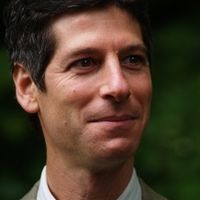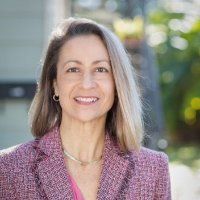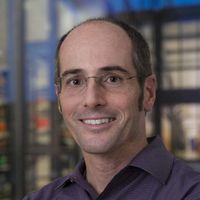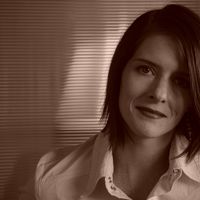It has been an awesome journey, learning from and sharing with so many of you!
Blog Post
A Chat with Nadav Malin, Hon. AIA

Nadav Malin stands among some redwoods at a recent Sustainable Design Leaders Summit.
Photo: Kelly PopeI sat down with Nadav to discuss this distinction and talk about some of the highlights of his 25-year career in the green building world.
First of all, what’s it like to receive this honor? How are you feeling?
It’s really exciting to receive this honor, and I feel really honored by it. And I’m especially glad because I think it reflects a valuing of the importance of sustainable design and health and resilience by the Institute and the profession as a whole.
It’s a little odd to be singled out for an award like this when everything I’m being recognized for is a team effort. It really reflects the impacts and achievements of all the people I’ve collaborated with at BuildingGreen and on the AIA committees and elsewhere.
How did you first get involved with green building? It all kind of started before green building was a Thing, right?
One of my very first summer jobs in high school was actually working as a laborer on a construction site where the team was building super-insulated homes. My job was to install 12 inches of fiberglass insulation in three layers in these double-stud walls. It was very itchy!
SUPPORT INDEPENDENT SUSTAINABILITY REPORTING
BuildingGreen relies on our premium members, not on advertisers. Help make our work possible.
See membership options »Right out of college, I was working in the construction industry, helping build houses in Southern Vermont. I was very interested in energy efficiency because I liked the idea of making houses more comfortable with lower energy bills and generating less pollution.
And through that, I discovered that there were some ancillary issues that also have to be addressed when you’re building energy-efficient homes, like indoor air quality and impacts from the harvesting and manufacturing of materials. I started exploring those issues when I joined Alex Wilson at BuildingGreen in 1991. And we started publishing Environmental Building News (now The BuildingGreen Report) in 1992.
You were there when the AIA’s Committee on the Environment was first getting off the ground. Can you talk a little bit about those early days with COTE?
It was a pretty small club in the early days, and there was a lot of excitement because it was such a new field that the question of what’s included under sustainable design or environmental impacts—and how to begin to think about those—was wide open.
The committee was always really excited to learn about each new building or project that was doing something innovative in terms of sustainability. And that led to the beginning of the COTE Top 10. The first couple years of the COTE Top 10 was really just the committee recognizing projects that they could find out about through word of mouth and networking.
And the committee really got a big boost with a million-dollar grant from the EPA to research the life-cycle impacts of materials and produce the Environmental Resource Guide. The Environmental Resource Guide was the first attempt to analyze the life cycle of building materials and understand their impacts in a way that would be useful to inform the decision-making process of designers.
Nadav facilitates the Sustainable Design Leaders Summit twice a year.
It’s hard to find now, but it actually has some information that’s still useful today.
You received this recognition in part because of your involvement with the Sustainable Design Leaders group. Tell me more about that group and what you have to do with it.
Working with the Sustainable Design Leaders is one of the highlights of my professional life.
This group was conceived of in 2008 by Meredith Elbaum and Nellie Reid as a network of sustainability directors in mid-size and large architecture firms who could help each other define their roles. It was a new role, and they didn’t have job descriptions.
So we worked with them to convene and facilitate a summit in the summer of 2008; this became the first annual A+D Sustainable Design Leaders Summit. “Summit” is a name that we chose to help people get funded by their firms to go. It’s really more of a retreat. We even contemplated calling it a “sandbox.”
My favorite description of these Summits came from a participant who called them “the best combination of professionalism, intimacy, and collaboration” he had ever experienced. There’s always a balance of focus on how to be more effective in the role of sustainable design leader within the firm and how to increase the impact of this group of leaders on the industry as a whole.
At the first Summit, we had a “no presentations” rule, but we discovered that people were sneaking off in the evening and using a projector to share cool resources with each other. So we started the tradition of five-minute presentations that has served us well ever since.
Planning and facilitating these meetings is a lot of fun!
You’ve had various roles with the U.S. Green Building Council (USGBC) and the LEED rating systems over the years. Tell me about some of the highlights.
When LEED came out of its pilot phase and was launched as version 2 (they skipped version 1), it was immediately recognized that there was a need for a larger committee structure to support the breadth of content that the system encompassed.
Architects Gail Lindsey and Bill Reed, who were chairing the committee set up to work on LEED version 3, asked me to head up a new technical advisory group [TAG] on materials and resources. That was in the year 2000.
I chaired that committee until 2008, and during that time I was also on the LEED Steering Committee and participating in formative workshops about the creation of LEED for Commercial Interiors and the evolution of the rating system in general.
I also was part of the Technical and Science Advisory Committee during that time, dealing in particular with the question of PVC and whether or not LEED should reward projects that avoid the use of it.
One of the issues that we dealt with repeatedly during my time as chair of the MR TAG was the forest certification debate: which forest certification programs should LEED recognize? We came up with several proposed resolutions on that issue, but at the end of the day, the USGBC membership as a whole chose not to change the program’s sole endorsement of the Forest Stewardship Council system. I think that decision came back to bite us with the release of the Legal Wood Pilot ACP in 2016.
More recently, I was hired to facilitate the Supply-Chain Optimization Working Group, which was tasked with developing guidelines for implementing the Supply-Chain Optimization option in LEED version 4’s material ingredients credit.
The AIA Environmental Resource Guide presents information that is still useful—if you can get your hands on a copy.
And BuildingGreen got even deeper into LEED by creating the LEEDuser website. Can you talk about that project?
We originally created the LEEDuser website with the support of USGBC when they recognized that LEED version 3 was coming out and they didn’t have the resources internally to provide the level of user support they thought would be needed. So we partnered with YR&G (now WSP Sustainability) and others to develop the content and turned it into a really robust forum for peer-to-peer sharing that’s helped a lot of people figure out the details of earning specific LEED points.
Looking back on your 25 years in the sustainable design world, what is your proudest moment?
Wow, that’s a tough one.
I don’t know if this is “proudest” exactly, but a pivotal moment in my career happened at a workshop that the U.S. General Services Administration sponsored at the Delving Deeper retreat in 2005. We had convened 30 leading thinkers and practitioners to explore what it would mean to delve deeper beyond the current sustainable design practices. And it was during that workshop that I discovered my talent as a facilitator, helping pull together the group into a compelling wrap-up conversation.
Since then, I’ve looked for opportunities to facilitate workshops and conversations of all kinds, and I continue to learn more each time I do it.
Another fun anecdote is about learning the value of being honest and transparent about what we’re doing. When we created a CD-ROM Guide to Green Building, we spent a conference session talking about lessons learned in the process of creating it; it ended up focusing on all the things that were wrong or limited about the tool. At the end of that session, there was a run on our booth to buy the CD-ROMs! I think people responded to the honesty and trusted that they knew exactly what they were getting.
Finally, once I was sitting down over lunch with a longtime subscriber and advisor to BuildingGreen, who summarized for me what people value about what we offer. He said, “You don’t give people fish; you teach them how to fish. You guys don’t try to give us easy answers. You just help us understand what are the most important questions to ask.”
I like to think that we’re always in search of better questions.
Published March 12, 2018 Permalink Citation
Melton, P. (2018, March 12). A Chat with Nadav Malin, Hon. AIA. Retrieved from https://www.buildinggreen.com/blog/chat-nadav-malin-hon-aia
Comments
Congrats!
We in the Architecture community has benefited from your work for so many years! This is well-deserved!
Congratulations Nadav on your AIA designation!
So glad you're getting recognized by the AIA for your decades of hard work on making buildings more sustainable.
Hear! Hear!
Well deserved, Nadav. You are such an (understated) asset to the green building community.
Well Deserved Nadav!
So appreciate all that you and BuildingGreen give to the community. Most valuable resource. Thank you!







Add new comment
To post a comment, you need to register for a BuildingGreen Basic membership (free) or login to your existing profile.